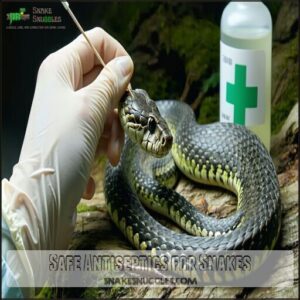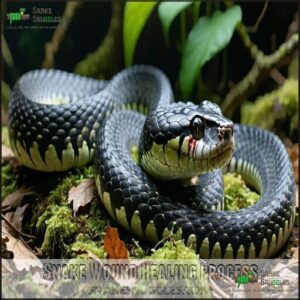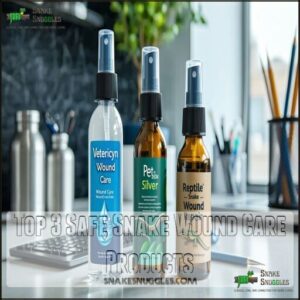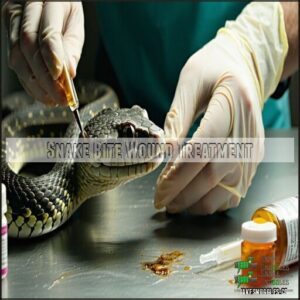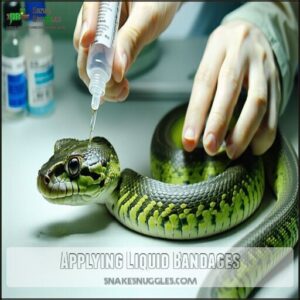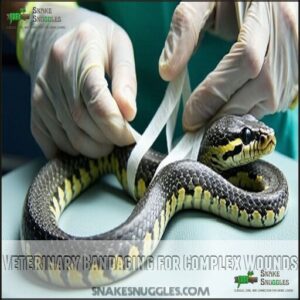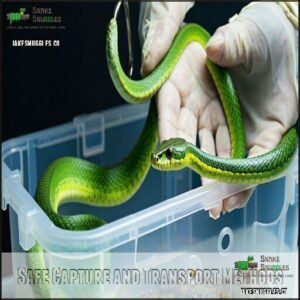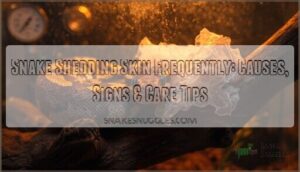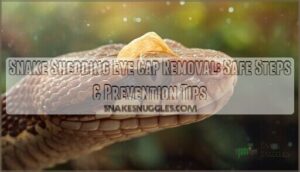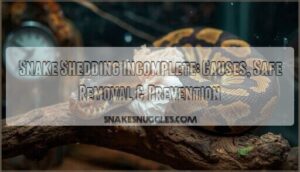This site is supported by our readers. We may earn a commission, at no cost to you, if you purchase through links.
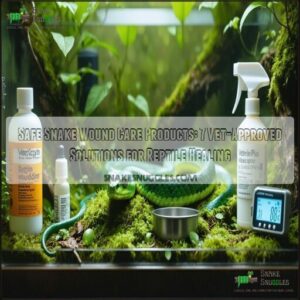
Vetericyn Plus Reptile Wound Care and Silver Sulfadiazine cream are top veterinary recommendations.
Unlike with mammals, avoid Neosporin with pain relief as it’s toxic to reptiles.
Always clean wounds with diluted Betadine (povidone-iodine) solution first, using a 10:1 water-to-Betadine ratio.
After application, keep your snake’s enclosure extra clean with fresh substrate.
Remember, a properly maintained recovery habitat makes all the difference between a quick heal and a costly vet visit.
The right temperature gradient particularly impacts how quickly those scales mend.
Table Of Contents
- Key Takeaways
- Snake Wound Care Basics
- Safe Antiseptics for Snakes
- Snake Wound Healing Process
- Top 3 Safe Snake Wound Care Products
- Snake Bite Wound Treatment
- Reptile Friendly Antibiotics
- Snake Wound Care Techniques
- Preventing Infection in Snakes
- Handling Injured Snakes
- Reptile Veterinary Care
- Frequently Asked Questions (FAQs)
- How do you clean a snake’s wound?
- Can a wounded snake heal?
- How do you treat a snake bite wound?
- How do you sanitize a snake?
- How do you clean a cut on a snake?
- Do snakes need stitches?
- What can I put on my snakes wound?
- What antibiotic ointment is safe for snakes?
- What is a safe antiseptic for reptiles?
- Can I put Neosporin on my snakes wound?
- Conclusion
Key Takeaways
- Use diluted Betadine solution (10:1 water-to-Betadine ratio) as your first line of defense for cleaning snake wounds, never using full-strength solution as it’s too harsh for reptile skin.
- Choose veterinarian-recommended products like Vetericyn Plus Reptile Wound Care or Silver Sulfadiazine cream, avoiding Neosporin with pain relief which is toxic to reptiles.
- Maintain a sterile recovery environment with paper towel substrate instead of particulate bedding, and keep the enclosure at the upper end of your snake’s preferred temperature range to accelerate healing.
- Monitor wounds daily for signs of infection (redness, swelling, discharge), minimizing handling to reduce stress, and don’t hesitate to consult a reptile-savvy veterinarian for serious injuries.
Snake Wound Care Basics
You’ll need to promptly clean your snake’s wound with diluted Betadine solution and maintain a sterile environment to prevent infection.
Regular monitoring for signs of infection, such as redness or unusual discharge, will guarantee your reptile companion heals properly while minimizing stress during recovery.
Cleaning The Wound With Diluted Betadine
For effective snake wound care, properly diluted Betadine is your first line of defense.
Mix the Betadine solution at a 1:10 ratio with distilled water until it resembles weak tea. Gently apply to the wound using sterile cotton swabs or create a 10-15 minute soak for affected areas.
You can purchase Betadine solution products online.
Monitor progress daily and discontinue if irritation occurs. Never use full-strength Betadine, as it’s too harsh for reptile skin, and always follow proper wound care guidelines.
Maintaining a Sterile Environment
A sterile environment is your snake’s best defense against infection.
While treating wounds, wash your hands thoroughly and use disposable gloves. Choose paper towels instead of particulate substrates during healing.
Implement strict cleaning protocols with safe antiseptics like diluted Betadine. Disinfect housing twice weekly with reptile-safe wound cleaning solutions.
Consider temporary quarantine procedures to maintain sterility. Remember, proper substrate selection and consistent hand hygiene dramatically reduce infection risks.
Monitoring for Signs of Infection
Now that your snake’s environment is clean, you’ll need eagle eyes for infection signs.
Watch your serpentine friend daily for these warning signals:
- Redness or unusual color changes around the wound
- Swelling that doesn’t improve after 24-48 hours
- Pus or discharge that’s yellow, green, or foul-smelling
- Appetite loss or refusal to eat for multiple feedings
- Lethargy or unusual hiding behavior
Don’t wait for symptoms to worsen—early intervention is your reptile’s best chance for smooth recovery.
Safe Antiseptics for Snakes
You’ll need to choose reptile-safe antiseptics like diluted Betadine solution or chlorhexidine when treating your snake’s wounds to prevent infection while avoiding harmful chemicals.
Products specifically formulated for reptiles, such as Vetericyn Plus and F10 disinfectant, offer effective wound care without the risks that human antiseptics might pose to your scaly friend, using antiseptics that are safe for them.
Betadine Solution for Reptile First Aid
Povidone-iodine, commonly known as Betadine Solution, is the gold standard for reptile first aid.
You’ll need to dilute it to a weak tea color (1:10 ratio) before application. For wound care, gently clean the affected area or create a 10-15 minute soak for your snake.
Unlike some alternative antiseptics, Betadine won’t harm healthy tissue when used correctly. Always rinse thoroughly post-treatment to prevent skin irritation.
For serious infections, systemic antibiotics may help.
Chlorhexidine for Wound Disinfection
While Betadine works wonders, chlorhexidine offers another excellent option for reptile wound disinfection. You’ll want to use a 0.05% chlorhexidine dilution—strong enough to kill bacteria but gentle on your scaled friend.
One can purchase chlorhexidine reptile products online.
- Apply with soaked gauze, not cotton (which reduces effectiveness)
- Allow 30 seconds to dry on dry areas, 2 minutes on moist areas
- Rinse with normal saline to remove residue
- Skip wounds that are already healing—it may disrupt the process
F10 Veterinary Disinfectant for Tank Cleaning
While chlorhexidine works wonders for direct wound care, F10 Veterinary disinfectant shines as the gold standard for tank cleaning.
You’ll find this powerful solution effective against bacteria, fungi, and viruses with proper F10 dilution.
Safe application requires following package instructions carefully—typically 1:500 for regular cleaning, and it’s also important to maintain a cleaning frequency of once weekly.
Don’t worry about residue concerns—F10 breaks down naturally, making it one of the most reptile-safe disinfectants available.
Snake Wound Healing Process
You’ll notice your snake’s wound healing differs from mammals, with recovery depending on proper temperature, nutrition, and a natural process tied to skin shedding cycles.
Understanding these factors helps you support your reptile’s remarkable healing capabilities, which work more slowly but efficiently when you maintain ideal environmental conditions, leveraging proper temperature to aid in the healing process.
Factors Affecting Healing Time
Understanding why some snake wounds heal faster than others helps you provide better care.
Several factors influence the reptile wound healing process:
- Wound shape matters – linear cuts heal faster than circular injuries as healing progresses from edges inward
- Temperature impact directly affects healing speed – maintaining the upper end of your snake’s preferred temperature range accelerates recovery
- Moisture levels substantially influence cell migration – proper humidity prevents wound desiccation
These factors can mean the difference between quick recovery and prolonged healing time for your scaly friend, and understanding them is crucial for providing the best possible care to ensure your snake heals faster.
Importance of Proper Nutrition and Temperature
Beyond healing time, your snake’s immune response and metabolic rate directly depend on proper nutrition and temperature.
When temperatures drop below ideal range, your snake’s healing speed slows dramatically.
You’ll notice faster wound healing at temperatures between 85-88°F, where nutrient absorption works efficiently.
Like a well-oiled machine, your reptile’s body repairs itself best when fueled with vitamin-rich foods and maintained within species-specific temperature gradients.
Role of Shedding Skin in Wound Healing
While proper temperature supports your snake’s metabolism, their unique shedding process is nature’s built-in wound healing mechanism.
When your reptile suffers an injury, the shedding cycle often accelerates in that area, creating a natural infection barrier.
This skin regeneration helps minimize scarring effects, as your snake’s body literally replaces damaged tissue with fresh skin—nature’s perfect bandage! You’ll notice healing rates improve with each shed.
Top 3 Safe Snake Wound Care Products
You’ll find these specially formulated products designed for reptile wounds can substantially improve your snake’s healing time while preventing dangerous infections.
These veterinarian-approved solutions contain gentle antimicrobial agents that won’t harm your scaled friend’s sensitive skin during recovery, which is a key aspect of using veterinarian-approved solutions.
1. Vetericyn Plus Reptile Wound Care
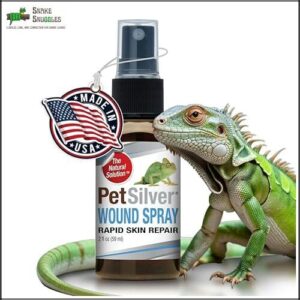 View On Amazon
View On Amazon Vetericyn Plus stands as the cornerstone of reptile first aid kits.
This non-toxic hypochlorous technology works wonders on reptile wounds, promoting healing when applied a few times daily.
You’ll appreciate that it’s pH-balanced and safe around sensitive areas like eyes and mouth—places where many antiseptics wouldn’t dare go.
Veterinarians recommend it as a safer alternative to traditional treatments like antibiotics and betadine.
Whether you’re dealing with lamp burns, scale rot, or bite wounds, this trusted solution helps reduce infection risk without harming healthy tissue.
It’s especially valuable for snakes, whose unique physiology requires specialized care.
Best For: Reptile owners looking for a safe, effective, and veterinarian-recommended solution for treating wounds, burns, and skin issues.
- Non-toxic and safe for use around sensitive areas like eyes, nostrils, and mouth.
- Reduces infection risk while preserving healthy tissue.
- Easy to apply and suitable for all types of reptiles.
- Requires frequent application for optimal results.
- May not be as effective for extremely severe infections without additional treatment.
- Limited to external use only, not for internal issues.
2. PetSilver Reptile Wound Care Spray

Made with patented chelated silver and distilled water, PetSilver Reptile Wound Care Spray offers a chemical-free solution for treating various reptile injuries.
You’ll find it effective for scale rot, lamp burns, scrapes, and skin irritations without causing any stinging or discomfort to your snake.
The spray format makes application straightforward—simply saturate the affected area and let it air dry.
What’s particularly reassuring is its safety if accidentally licked or ingested by your reptile.
Users report impressive results, including healed skin rips in pythons and resolved scale rot after shedding, which demonstrates the product’s effectiveness in promoting healed skin.
Best For: Reptile owners seeking a safe, natural, and effective solution for treating wounds, scale rot, burns, and skin irritations.
- Natural formula with patented chelated silver and distilled water, free from chemicals.
- Safe for use on all body parts, even if licked or ingested.
- Easy spray application with no stinging or discomfort for the reptile.
- Requires cleaning the reptile after use to avoid contaminating their water.
- One reported case of an iguana’s death, though the link to the product is unclear.
- Some users might find the bottle size small for frequent use.
3. NutriRise Reptile Skin Wound Care
During emergency situations, NutriRise Reptile Skin Wound Care stands out with its pH-balanced hypochlorous technology.
This vet-recommended solution works effectively around sensitive areas like your snake’s eyes and mouth while promoting skin regeneration.
You’ll appreciate its non-toxic formula as a safe alternative to traditional treatments like betadine and chlorhexidine.
One snake owner successfully treated their bearded dragon’s chin cut by applying it 2-3 times daily with a q-tip, avoiding costly vet bills.
With dimensions of 4.57 x 1.42 x 1.34 inches, it’s a compact addition to your reptile first aid kit, providing a vet-recommended solution.
Best For: Reptile owners seeking a safe, effective, and vet-recommended solution for managing skin injuries and conditions.
- Non-toxic, pH-balanced formula safe for sensitive areas.
- Promotes fast healing and reduces the risk of infection.
- Easy-to-use spray simplifies reptile wound care.
- Requires multiple daily applications for optimal results.
- Small bottle may not last long for frequent use.
- Not a substitute for professional care in severe cases.
Snake Bite Wound Treatment
You’ll need to act quickly when treating snake bite wounds, using diluted Betadine solution to clean the affected area.
This initial treatment is crucial for preventing infection, and applying appropriate reptile-safe antibiotics like silver sulfadiazine cream is essential.
During recovery, it’s vital to maintain ideal temperature conditions and reduce handling to minimize stress, allowing your scaled companion to heal comfortably in a clean environment.
Antivenin Administration
When snake bites strike, time becomes your most precious resource.
Antivenin administration works best within 4 hours of a venomous snake bite. The life-saving medication comes in monovalent (specific to one species) or polyvalent (treats multiple snake types) formulations.
It’s administered intravenously, diluted in saline solution, with a slow initial infusion rate to monitor for allergic reactions before increasing the flow, which is crucial for effective antivenin administration.
Pain Management and Medication
After antivenin treatment, managing your snake’s pain becomes the next priority.
Always consult a reptile-savvy vet for proper pain medication for snakes, as dosage safety is critical with these sensitive creatures.
Your pain relief options include:
- NSAIDs for snakes – Used rarely and with extreme caution
- Opioids for snakes – Vet-administered only
- Local anesthetics – For immediate relief
- Environmental analgesic options – Creating a stress-free recovery environment
Wound Cleaning and Disinfection
Prompt and thorough wound cleaning is your first defense against infection after a snake bite.
Clean the area with reptile-safe antiseptic like diluted Betadine (1:10 ratio) or chlorhexidine solution. Apply using sterile technique—gently dab, don’t scrub.
Different disinfectant types suit various situations, but frequency matters; clean 1-2 times daily until healing begins.
Remember, proper wound disinfection substantially improves recovery outcomes for your scaled companion. It’s also vital to recognize that envenomation symptoms can vary greatly and impact recovery outcomes.
Reptile Friendly Antibiotics
You’ll need vet-prescribed antibiotics like Ampicillin or Ceftazidime when your reptile’s wound shows signs of infection, as these medications are specifically formulated to combat bacterial threats while being safe for your scaled companion.
Always consult your exotic veterinarian before administering any antibiotic treatment, as proper dosage is essential to effective healing without causing harm to your snake’s sensitive system, and this is crucial for proper dosage and effective healing.
Ampicillin for Bacterial Infections
When bacterial infections threaten your reptile’s health, Ampicillin offers targeted treatment, though with important limitations.
You’ll need to administer 20-50 mg/kg orally every 1-2 days, with specific maximums for different species (40 mg/kg for tricolor, king, indigo, and Uracoan rattlesnakes).
Be aware that Ampicillin shows high resistance rates in snakes and may not effectively combat common bacteria, potentially necessitating alternative antibiotics for ideal reptile health.
You can find reptile-specific ampicillin products online.
Azithromycin for Respiratory Issues
When respiratory infections strike your serpentine companion, Azithromycin steps in as a highly effective antibiotic.
Typically administered at 10mg/kg every 72 hours, this medication targets bacterial respiratory issues in snakes.
The treatment duration usually spans 2-3 weeks, and you should watch for side effects like reduced appetite or lethargy.
Unlike some alternative antibiotics, Azithromycin has fewer resistance concerns, making it a preferred choice for reptile health professionals treating persistent respiratory problems.
Ceftazidime for Severe Infections
While azithromycin tackles respiratory issues, Ceftazidime is your heavy artillery for severe snake infections.
This powerful antibiotic works wonders against resistant bacteria that other medications can’t touch.
Proper injection techniques are essential—most reptile-savvy vets administer it every 72 hours.
Watch for side effects like reduced appetite or lethargy.
Remember, antibiotics aren’t DIY treatments; always consult your vet for appropriate Ceftazidime dosage to avoid resistance development in your scaly friend, and use it as a powerful antibiotic.
Snake Wound Care Techniques
You’ll need specialized techniques to properly care for your snake’s wounds, from applying liquid bandages for minor abrasions to using veterinary bandaging for more complex injuries.
Proper wound management techniques substantially improve healing time and prevent infections, so you’ll want to master these essential skills before your scaly friend needs them, which involves understanding the importance of proper wound management.
Applying Liquid Bandages
Moving beyond internal antibiotics, liquid bandages offer an effective external barrier for superficial abrasions on your snake.
Apply reptile-safe brands like Vetericyn Plus or Reptanicals in a thin layer application to clean, dry wounds.
Verify proper ventilation by never covering the treated area, and monitor daily for infection signs like unusual coloration or discharge.
Remember, these products work best where the skin is minimally broken – never use on deep wounds or around the eyes.
Using Medical-grade Honey for Wound Healing
While liquid bandages provide protective barriers, medical-grade honey offers natural healing power for your snake’s wounds.
This sterilized wonder creates a moist environment that promotes tissue repair while fighting bacteria without causing resistance.
Apply a thin layer directly to clean wounds or use honey-infused dressings.
Unlike table honey, medical-grade varieties like Manuka contain specific compounds that accelerate healing.
You’ll need frequent applications for best results, but the antimicrobial protection is worth it!
Veterinary Bandaging for Complex Wounds
While medical-grade honey works wonders for many wounds, some complex snake injuries need more structured support.
For these cases, veterinary bandaging offers specialized protection, including tie-over bandages (great for any body area) and modified Robert Jones (MRJ) bandages (better for limbs).
Always clean wounds thoroughly with dilute chlorhexidine before applying the primary contact layer, the secondary bulk layer, and the tertiary protective layer.
Preventing Infection in Snakes
You’ll substantially reduce infection risk in your snake’s wounds by maintaining a pristine enclosure with appropriate substrate and consistently monitoring healing progress.
Creating a low-stress environment with proper temperature gradients and hiding spots will boost your reptile’s natural immune response, helping wounds heal faster without complications.
Maintaining a Clean Environment
After dressing your snake’s wound, environment cleanliness becomes your next defense against infection.
Your substrate choice directly impacts healing – opt for paper towels instead of particulate beddings that might stick to wounds.
Establish a daily waste removal routine and maintain pristine water quality.
Use reptile-safe disinfectants like F10 or diluted chlorhexidine for enclosure cleaning.
Follow proper quarantine protocols if you have multiple reptiles, and increase disinfection frequency while your scaly friend recovers, using methods that ensure complete cleanliness.
Reducing Stress and Promoting Recovery
A clean snake environment is just half the battle. Stress can substantially delay healing and increase infection risk in wounded reptiles.
To create a supportive environment for recovery:
- Provide a quiet recovery space with appropriate hiding spots
- Maintain ideal temperature and humidity for your snake’s species
- Practice gentle handling techniques, minimizing contact when possible
- Offer nutritional support with easy-to-digest prey items
Remember, a relaxed snake heals faster than a stressed one! Maintaining proper cage hygiene is also vital.
Handling Injured Snakes
You’ll need specialized tools and gentle movements when handling an injured snake to prevent further trauma and guarantee your safety.
When transporting your wounded reptile, secure it in a ventilated container with minimal disturbance, maintaining a comfortable temperature that supports its healing process.
Safe Capture and Transport Methods
A snake hook in one hand and calm nerves can make all the difference when dealing with injured reptiles.
When capturing and transporting wounded snakes, gentle restraint is essential to prevent further injury.
| Method | Equipment Needed | Safety Level |
|---|---|---|
| Pillowcase | Cotton pillowcase, twist tie | Medium |
| Clear container | Plastic bin with air holes | High |
| Snake tongs | Professional snake hook, gloves | Advanced |
Use secure containers with adequate airflow during transport, maintaining appropriate temperature control to minimize stress, and always prioritize the snake’s safety with proper handling and adequate care.
Providing a Quiet and Warm Recovery Space
Now that you’ve safely transported your injured snake, it’s time to create the right healing environment. Your reptile needs a quiet recovery space with ideal temperature control (around 85°F) to support their immune system and healing process.
- Use a clean tank with simple paper towel substrate to prevent wound contamination
- Provide at least two comfortable hiding spots so your snake feels secure and protected
- Position the enclosure in a low-traffic area of your home to minimize stress, which is crucial for the snake’s recovery and to ensure the healing process is not disrupted.
Minimizing Stress and Promoting Healing
With your recovery space set up, you’ll need to focus on minimizing stress – the secret ingredient for wound healing in reptiles.
Handle your injured snake only when absolutely necessary, using gentle techniques that support their entire body. Keep interactions brief and predictable. Garter snakes are especially prone to handling injuries due to their delicate builds.
| Stress Reduction Strategy | Benefit | Implementation |
|---|---|---|
| Limited handling | Reduces wound irritation | Touch only during treatment |
| Hiding places | Promotes security | Add multiple hides in enclosure |
| Proper nutrition | Supports immune function | Offer smaller, easier meals |
| Temperature control | Accelerates healing | Maintain ideal gradient for species |
Reptile Veterinary Care
You’ll need a reptile-savvy veterinarian for proper diagnosis and treatment of snake wounds, as these specialized professionals understand the unique healing processes of reptiles.
When you establish regular check-ups with an experienced herp vet, you’re not just treating immediate issues but also preventing future complications through proper enclosure setup and maintenance advice.
Importance of Consulting a Reptile-savvy Vet
While proper home care matters, nothing replaces a reptile-savvy vet’s expertise for snake wound care.
Unlike regular vets, reptile specialists can:
- Provide expert wound assessment specific to your snake’s species
- Create specialized treatment plans for complex injuries
- Prescribe proper medication dosage suited to reptiles
- Recognize subtle symptoms that might escape an untrained eye
Don’t gamble with DIY solutions when your scaled companion needs professional veterinary care for complex injuries.
Scheduling Regular Check-ups for Health Monitoring
Through preventative care, you’ll catch potential issues before they become serious problems.
Schedule regular checkups with a reptile veterinarian every 6-12 months—just like you’d change your car’s oil.
These visits enable early detection of health concerns through parasite screening and thorough examinations.
Your vet will track health trends over time and provide a husbandry review, ensuring your snake’s environment supports ideal healing and wellness.
Maintaining Safe Enclosures and Proper Ventilation
While your snake recovers from wounds, maintaining a safe environment becomes doubly important for healing success.
Your enclosure’s design directly impacts your reptile’s recovery speed.
- Secure all doors and lids to prevent escape attempts during discomfort
- Implement proper ventilation methods using mesh panels or vents
- Create appropriate temperature gradients with reliable heating equipment
- Monitor humidity control daily using digital hygrometers
- Choose smooth, digestible substrate that won’t irritate wounds
Frequently Asked Questions (FAQs)
How do you clean a snake’s wound?
To clean a snake’s wound, gently wipe the area with diluted Betadine solution (1:10 ratio).
You’ll want to make certain the area remains dry afterward and use paper towels instead of rough bedding to prevent irritation.
Can a wounded snake heal?
Yes, your wounded snake can heal completely with proper care.
Reptiles naturally recover from superficial injuries, often through shedding.
Deeper wounds take longer but will heal if you maintain ideal temperature and prevent infection.
How do you treat a snake bite wound?
When bitten by a snake, immediately call emergency services.
Clean the wound gently, keep it below heart level, remove jewelry, and don’t apply tourniquets.
Never cut, suck, or use ice on the bite.
How do you sanitize a snake?
Properly prepare a diluted Betadine solution (1:10 ratio) for your slithery companion.
You’ll want to soak your snake for 10-15 minutes, using only reptile-safe products like Vetericyn or Ceragyn.
Never use rubbing alcohol or hydrogen peroxide, as these are not reptile-safe.
How do you clean a cut on a snake?
Gently clean your snake’s cut with diluted Betadine solution (1:10 ratio).
Using a cotton swab, dab the wound carefully, keep the area dry, and monitor for signs of infection like redness or swelling.
Do snakes need stitches?
In the serpentine world of injuries, some wounds speak louder than others.
Your snake may need stitches for deep lacerations or large wounds, but most minor cuts heal naturally with proper cleaning and veterinary guidance.
What can I put on my snakes wound?
For snake wounds, you can use diluted Betadine solution (1:10 ratio), reptile-safe antibacterial products like Vetericyn, or thin layers of medical-grade honey.
Always clean the area first and monitor for signs of infection.
What antibiotic ointment is safe for snakes?
When your scaly friend needs a little TLC, use Neosporin (without pain relief) sparingly.
Silver sulfadiazine cream or medical-grade honey are also safe options.
Always monitor for reactions and consult your reptile vet.
What is a safe antiseptic for reptiles?
You’ll find diluted Betadine solution (1:10 ratio) is the safest antiseptic for your reptilian friends. Chlorhexidine and reptile-specific products like Vetericyn also work well for wound cleaning without causing harm.
Can I put Neosporin on my snakes wound?
Yes, you can use Neosporin sparingly on your snake’s minor wounds, but monitor closely for reactions.
It’s safe for non-venomous bites, though reptile-specific products are generally better alternatives for wound care.
Conclusion
Like Cleopatra’s fabled asps, your scaled friend deserves royal treatment when injured.
Remember, using safe snake wound care products isn’t just about immediate treatment—it’s about creating the ideal healing environment.
You’ll save money, reduce stress, and guarantee faster recovery by having Vetericyn Plus, diluted Betadine, and Silver Sulfadiazine on hand.
Maintain proper temperatures, keep enclosures pristine, and don’t hesitate to consult your exotic vet when in doubt.


